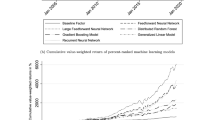Abstract.
Networks of companies can be constructed by using return correlations. A crucial issue in this approach is to select the relevant correlations from the correlation matrix. In order to study this problem, we start from an empty graph with no edges where the vertices correspond to stocks. Then, one by one, we insert edges between the vertices according to the rank of their correlation strength, resulting in a network called asset graph. We study its properties, such as topologically different growth types, number and size of clusters and clustering coefficient. These properties, calculated from empirical data, are compared against those of a random graph. The growth of the graph can be classified according to the topological role of the newly inserted edge. We find that the type of growth which is responsible for creating cycles in the graph sets in much earlier for the empirical asset graph than for the random graph, and thus reflects the high degree of networking present in the market. We also find the number of clusters in the random graph to be one order of magnitude higher than for the asset graph. At a critical threshold, the random graph undergoes a radical change in topology related to percolation transition and forms a single giant cluster, a phenomenon which is not observed for the asset graph. Differences in mean clustering coefficient lead us to conclude that most information is contained roughly within 10% of the edges.
Similar content being viewed by others
References
The economy as an evolving complex system II, edited by W.B. Arthur, S.N. Durlauf, D.A. Lane (Addison-Wesley, Reading, Massachusetts, 1997)
H.M. Markowitz, J. Finance 7, 77 (1952)
R. Albert, A.-L. Barabási, Rev. Mod. Phys. 74, 47 (2002); S.N. Dorogovtsev, J.F.F. Mendes, Evolution of Networks: From Biological Nets to the Internet and WWW (Oxford UP, 2003)
G. Caldarelli, S. Battiston, D. Garlaschelli, M. Catanzaro, in Complex Networks, edited by E. Ben-Naim, H. Frauenfelder, Z. Toroczkai (Springer, 2004)
J.-P. Onnela, A. Chakraborti, K. Kaski, J. Kertesz, A. Kanto, Phys. Scr. T 106, 48 (2003)
R.N. Mantegna, Eur. Phys. J. B 11, 193 (1999)
L. Kullmann, J. Kertész, R. Mantegna, Physica A 287, 412 (2000)
J.-P. Onnela, A. Chakraborti, K. Kaski, J. Kertész, Eur. Phys. J. B 30, 285 (2002)
J.-P. Onnela, A. Chakraborti, K. Kaski, J. Kertész, A. Kanto, Phys. Rev. E 68, 056110 (2003)
J.-P. Onnela, A. Chakraborti, K. Kaski, J. Kertész, Physica A 324, 247 (2003)
G. Bonanno, F. Lillo, R.N. Mantegna, Quantitative Finance 1, 96 (2001)
G. Bonanno, N. Vandewalle, R.N. Mantegna, Phys. Rev. E 62, R7615 (2000)
L. Kullmann, J. Kertész, K. Kaski, Phys. Rev. E 66, 026125 (2002)
M. Mehta, Random Matrices (Academic Press, New York, 1995)
L. Laloux et al. , Phys. Rev. Lett. 83, 1467 (1999)
V. Plerou et al. , Phys. Rev. Lett. 83, 1471 (1999)
S. Pafka, I. Kondor, Physica A 319, 487 (2003)
I.T. Joliffe, Principal Component Analysis (2002, Heidelberg, Springer); R. Brummelhuis, A. Cordoba, M. Quintanilla, L. Seco, Mathematical Finance 12, 23 (2002)
A. Hyvärinen, Neural Computing Surveys 2, 94 (1999); A.D. Back, A. Weigend, Int. J. Neural System 8, 473 (1997)
B. Bollobás, Random Graphs, 2nd edn. (Cambridge University Press, 2001)
Forbes at http://www.forbes.com/, referenced in March-April, 2002
Author information
Authors and Affiliations
Corresponding author
Additional information
Received: 11 December 2003, Published online: 14 May 2004
PACS:
89.65.-s Social and economic systems - 89.75.-k Complex systems - 89.90. + n Other topics in areas of applied and interdisciplinary physics (restricted to new topics in section 89)
Rights and permissions
About this article
Cite this article
Onnela, JP., Kaski, K. & Kertész, J. Clustering and information in correlation based financial networks. Eur. Phys. J. B 38, 353–362 (2004). https://doi.org/10.1140/epjb/e2004-00128-7
Published:
Issue Date:
DOI: https://doi.org/10.1140/epjb/e2004-00128-7




